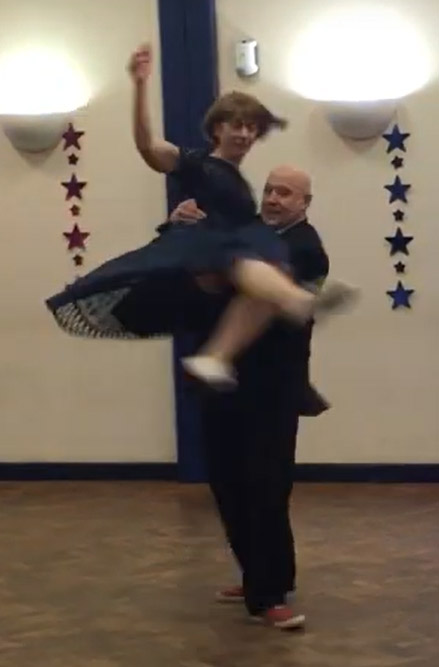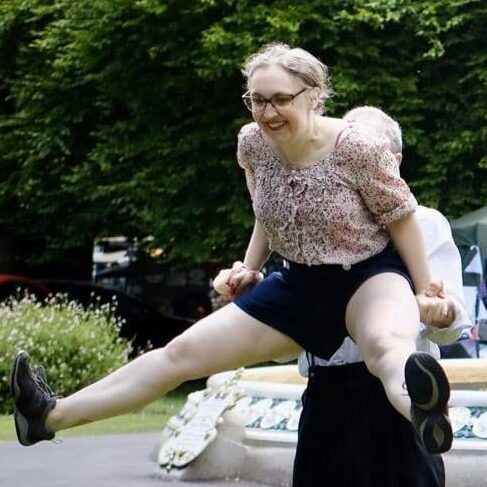Our Classes
Matt and Jane, supported by a small team of excellent teachers, teach weekly Lindy Hop classes for Cheltenham Swing Dance. They thoroughly enjoy seeing dancers leave their classes with something new and fun to play with on the social dance floor.
Matt and Jane say, “We are very lucky to have attended many Lindy training camps and have brought back tips, techniques and teaching methods that we found really improved our enjoyment of the dance. We would absolutely love to share this with as many dancers as we can. We want everyone to fall in love with Lindy Hop!”

Class Timings
Classes follow the school terms. You can always email to check, but if schools are open, so are we! Our lesson format is:
Time |
Main Hall |
Small Hall |
19:00 |
Doors open for a chat and a social dance |
Doors open |
Class 1 19:15 – 20:00 |
Beginner class. Suitable for complete beginners. It is preferable to start when we begin a new course (January, after Easter or September) but we aim to accommodate new starters at other times. Drop us an email if you are unsure. |
|
20:00 – 20:15 |
Social dance time |
(Social dance in main hall) |
Class 2 20:15 – 21:00 |
||
21:00 – 21:15 |
Social dance time |
(Social dance in main hall) |
Class 3 21:15 – 22:00 |
Variety This could be anything from Jazz to technique, or anything in between. |
(Class in main hall) |
22:15 |
Close-up |
Close-up |
Prices: £7 one class, £10 two classes, £12 all three classes (on the same night).
Pay on the door - cash or card.
Come along, we’d love to see you there.
Wednesday evenings (classes are term-time only)
Dowty Sports & Social Club
Yes, you can just drop in!
Our Teaching Team

Jane Day

Matt Day

Anita Syvret

Keith Southern

Jo Godley
Class Level Information
Our level |
Descriptor |
You will already know: |
You will learn: |
Suitable for complete beginners, and those who want to refresh their fundamentals or pick up some useful tips. |
Nothing! |
6-count pattern 8-count pattern Basic partner connection. Simple 6-count and 8 count-shapes Side-by-side Charleston Basic Swing Out, Lindy Turn, Lindy Circle |
|
For anyone who wants to do a bit more at Beginner level. Suitable for anyone following the Beginners’ course. |
To have been to at least one Beginners’ lesson! That’s right – just one! |
Build on and practice moves from Beginners Refine your basics Practice side by side Charleston |
|
Suitable for those who have done a term of 6-count, a term of 8-count in Beginners AND have those basics under control. |
6-count pattern 8-count pattern Swing Out Lindy Turn Lindy Circle |
How to improve your connection Transitions between 6-count and 8-count moves More about lead and follow techniques Additional moves and styling. Details of the Swing Out family of moves (incl inside turn, outside turn, Texas Tommy) Some jazz steps |
|
You are familiar with both rhythms and patterns as well as the technique that comes with it. This level will both improve the execution of core material and provide you with more challenging content. |
Swing Out Lindy Turn & Circle Basic Charleston Have met a few jazz steps Happy to mix 6 and 8 count moves |
Loads more moves Variations Different ways to Swing Out Charleston moves Lead and follow: the responsibilities each has in the partnership Incorporating jazz steps into partner dancing Exploring musicality Understanding the building blocks of the dance. |
|
You want to spend time on detail and are ready to be challenged. You are not put off by being pushed outside of your comfort zone. You are knowledgeable, and happy to experiment with rhythm changes and the conversation between lead and follow. |
We don’t need to list moves here; it’s no longer about moves, is it? |
It’s all 2-beat A more detailed look at the concept of connection and frame-matching More intricate variations More technique Jumps, dips and lifts Fast and slow tempo techniques Breaking away Playing within the dance |
|
The Variety class is a chance to learn something you may not otherwise. |
This will change frequently. For example: we may recap the Shim Sham, look at rock steps, or work on spins and turns – it could be anything! Whatever it is, it will often be something to take away and work on. |
Dancers use fundamentals all the time, in complex patterns as well as simple shapes. Whether you’re stepping or sliding, jumping or flying, the quality of your fundamentals impacts every part of your dance. That’s why they’re something we should all work on throughout our dancing life.








